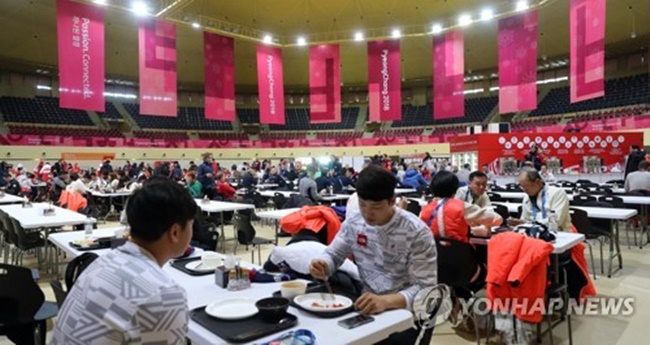
At its peak, the athletes’ village kitchen will serve 7,000 meals daily, up from a current 2,500 meals three days before the opening ceremony. (Image: Yonhap)
GANGNEUNG, South Korea, Feb. 6 (Korea Bizwire) – Do you want a traditional English fry-up for breakfast? Or a Korean spread made up of rice, seaweed soup and kimchi? How about a lamb samosa from a halal kitchen, or a sandwich made with gluten-free bread?
Here at the athletes’ dining hall in the Gangneung Olympic Village of the 2018 PyeongChang Winter Olympics, you can choose one or two options from the lists for breakfast, or you can enjoy them all at one table.
It is a food court like no other. It has a variety of dishes, drinks and snacks, but is aimed at offering the world’s elite athletes healthy, hearty food at all hours.
Some 180 chefs, including 30 halal cooks, are working in the kitchen to prepare 180 dishes every day. The menu changes every seven days with a total of 406 dishes.
At its peak, the athletes’ village kitchen will serve 7,000 meals daily, up from a current 2,500 meals three days before the opening ceremony.
Diners can choose from six different buffets — salad bar, Italian, Asian, world, Korean and halal.
In particular, the salad bar, which is available 24 hours a day, has cold dishes, bread, cereal, fruit and so on, with gluten-free bread and cereal also available.
A chef carves roast beef at the world section, which is also filled with steak, roast chicken, lamb chops, making it an attractive option for meat eaters.
“They are athletes. They love meat like steak and chicken breasts,” head chef Yang Eui-yong told reporters during a media tour on Tuesday. “Unexpectedly, however, Korean food is popular among athletes here.”
At the Korean food station, Korean barbecue is served with kimchi, the country’s famous dish made with fermented cabbage, scallions and assorted vegetables, a soup and other side dishes. A group of seasoned vegetables and chili pepper paste is on the corner for bibimbap, a dish of mixed rice served in a bowl.
“Yesterday, the main menu was ‘galbi,’ a Korean barbecue. We had thought some 50 kilograms of meat would be consumed, but they ate 100 kg,” he said. “They like bibimbap very much, and gimbap, or Korean rice rolls, is popular too.”
The restaurant also has a special catering service providing birthday cakes on two-day notice.
Village residents are also satisfied with the variety of the menu at the dining hall.
“I love the salad bar the most. It’s fresh and tasty. It has everything,” said a Canadian member, who refused to give her name. “I tasted Korean food. It’s nice.”
The chef said he will make more efforts to maintain the quality of the food and keep the restaurant safe and clean.
“Recently, I had a meeting with team doctors from each delegation. They said they are satisfied with the menu’s nutrition and taste,” said Yang. “We’ll not let our guard down until the end of the Olympics.”
(Yonhap)






